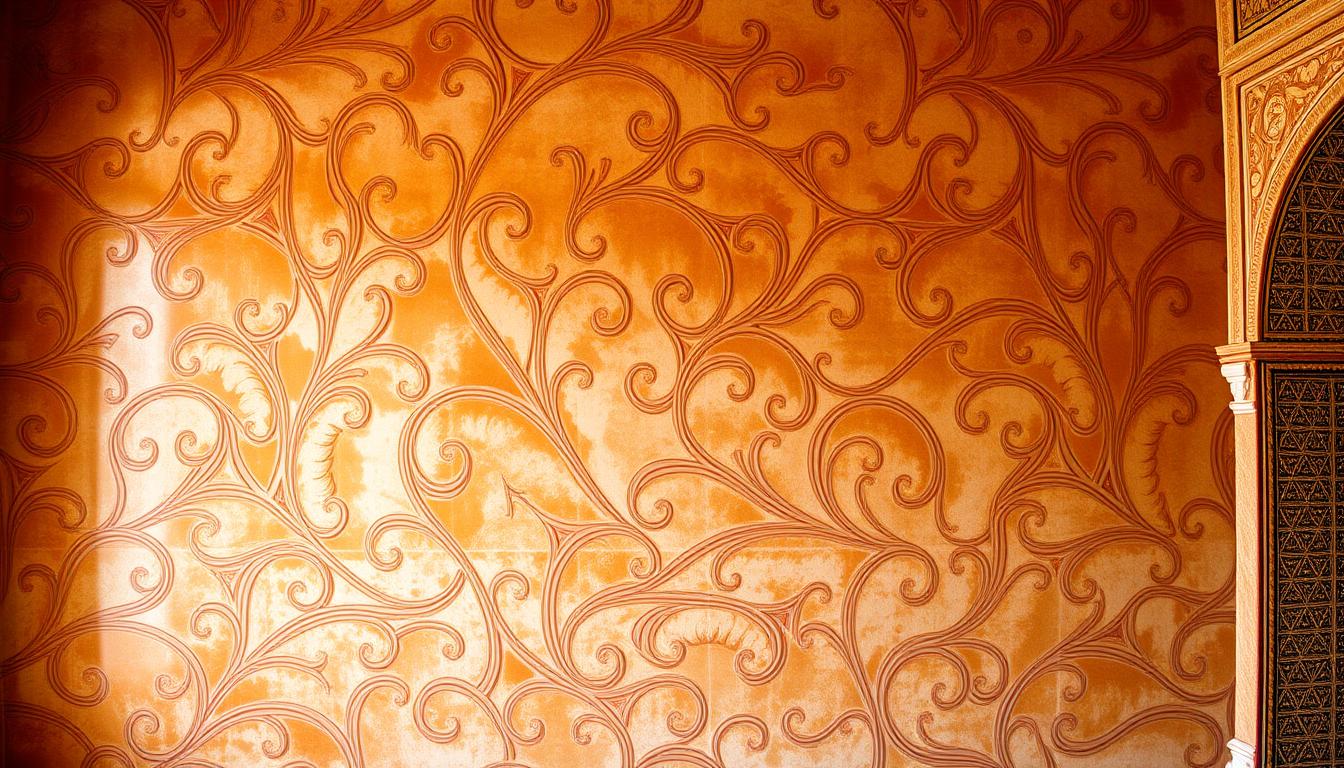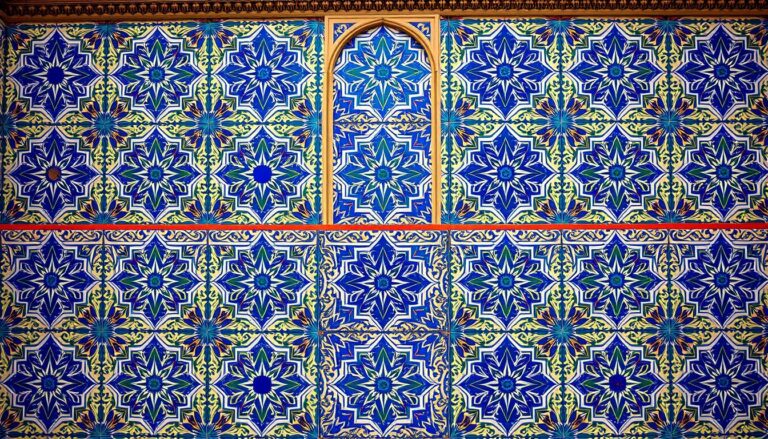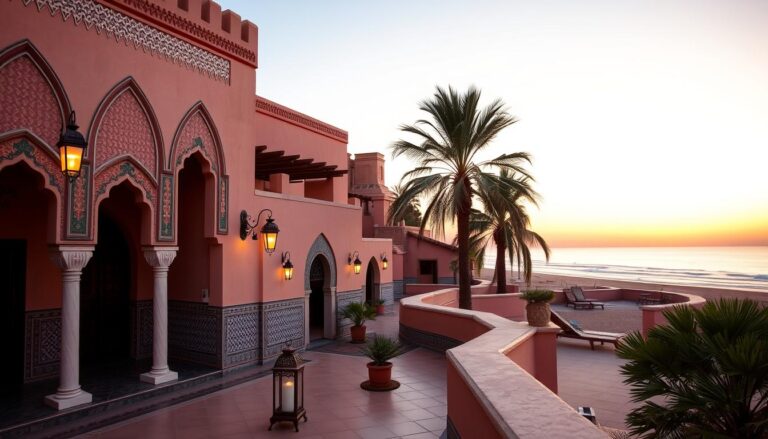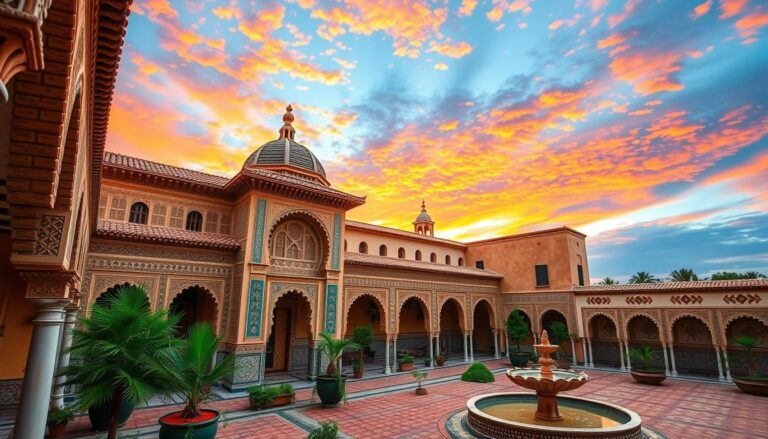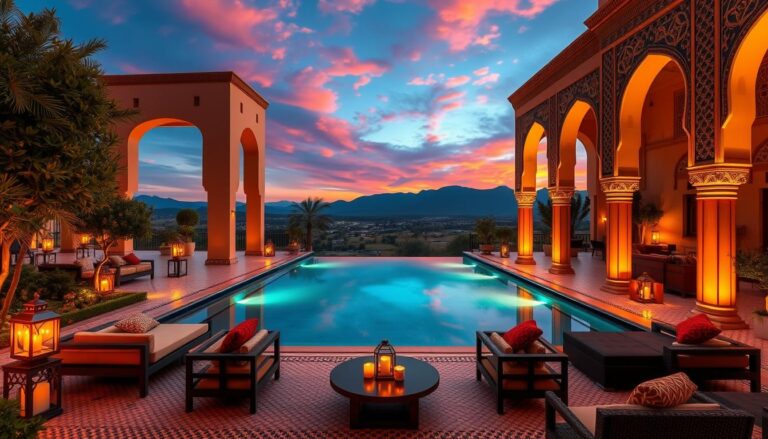When we think of Moroccan design, we often picture bright colors and detailed patterns. But have you ever thought about the history and skill behind the famous plaster technique used in many Moroccan homes? This method, called tadelakt, is a special plaster made from limestone. It gives walls a unique and eye-catching look.
Tadelakt is loved by designers for its shiny, smooth, and sculptural quality. It’s especially popular for bathrooms. To make it, lime plaster is applied, shaped, and then buffed with a hard stone. Finally, olive oil soap is used to seal it, making it perfect for wet places.
Key Takeaways
- Tadelakt is an ancient Moroccan plastering technique that creates a unique, water-resistant finish.
- The process involves applying lime plaster, shaping it, and then buffing it to a lustrous sheen.
- Tadelakt has gained popularity in modern design, particularly for bathrooms and other wet areas.
- This versatile plaster can be used in various indoor spaces, from kitchens to bedrooms.
- Tadelakt offers a sustainable and customizable option for homeowners seeking a distinctive aesthetic.
So, why do designers and homeowners love tadelakt so much? Let’s explore its origins and the artistry behind this Moroccan plaster technique.
Unveiling the Ancient Tadelakt Technique
Tadelakt, a lime plaster finish, comes from the Berber tribe in Morocco. It’s a method passed down for generations, key to Moroccan architecture. It was first used in the High Atlas near Marrakech, showing its water-resistant qualities.
Origins and History of Tadelakt
The 12th century marks the start of tadelakt, used for cisterns, water tanks, and hammams. Its smooth finish made it popular for many uses indoors and outdoors.
The Traditional Berber Plastering Method
The Berber technique for tadelakt is detailed. Lime plaster is applied, molded, and buffed with a hard stone. This hard work, passed down orally, adds to tadelakt’s charm.
Tadelakt’s journey from the Berbers to Moroccan and Islamic architecture shows the value of traditional skills. It still attracts designers and homeowners who love its look and benefits.
“Tadelakt is an art form with inherent imperfections that are part of its appeal.”
Tadelakt: A Seamless and Sculptural Aesthetic
The ancient Moroccan and Middle Eastern plastering technique, tadelakt, has won over modern designers. It can be molded into any shape and has a lustrous, water-like tadelakt aesthetic. This gives it a seamless plaster finish and sculptural plaster designs. It’s cool to the touch, creating a cave-like feel that’s both inviting and luxurious.
The hand-applied tadelakt adds a special, high-end touch. It’s perfect for modern, minimalist interiors that still feel warm and full of character. Its water-resistant nature and ability to be colored in various ways make it practical and eco-friendly for many architectural uses.
The Lustrous and Tactile Appeal of Tadelakt
The lustrous, water-like finish of tadelakt comes from the traditional Berber plastering method. This involves burnishing the plaster with a smooth stone or trowel. This process makes the surface visually striking and incredibly tactile, inviting touch and exploration.
The material’s cool temperature and smooth, almost velvety texture add to its cave-like, soothing ambiance. It’s a favorite for modern, minimalist spaces that aim to balance simplicity with warmth and character.
“Tadelakt has a timeless, sculptural quality that is both modern and ancient. Its ability to be molded into any shape, combined with its lustrous, water-like finish, makes it a truly unique and desirable material for contemporary design.”
Applying tadelakt is labor-intensive, requiring specialized techniques and training. This adds to its exclusivity and appeal. Its durability, lasting for centuries, makes it a long-term investment in both residential and commercial projects.
Stucco decorations (tadelakt) in Moroccan Architecture
Tadelakt, an ancient Moroccan plastering technique, is a key part of the country’s architecture. It’s water-resistant and sculptural, making stunning decorations. These decorations show Morocco’s vibrant, traditional design.
Tadelakt is found in famous hammams and in homes and businesses. Its shiny, water-repellent finish makes it popular. It shows Morocco’s skill in using this versatile plaster.
The Berber tribe started using tadelakt, especially in steam baths. Its water-resistant and sculptural qualities have made it popular in Moroccan design.
“Tadelakt is often used for finishing ornaments, bathrooms, kitchens, and fireplaces to achieve a luxurious and elegant appearance.”
Over time, tadelakt has been used by many cultures, like the Romans and Aztecs. It’s seen in the Alhambra palace and Almohad monuments. Tadelakt has always been a part of Morocco’s architecture.
Today, tadelakt is still celebrated. Artisans and designers use it in modern designs. It shows Morocco’s creativity and skill in design.
The Practical Benefits of Tadelakt
Tadelakt is not just beautiful; it’s also very practical. It’s perfect for places that get wet a lot, like bathrooms. This tadelakt plaster system is easy to care for and good for the planet. It comes in many tadelakt color options to fit any tadelakt bathroom design.
Water-Resistant and Low-Maintenance
The way tadelakt is made makes it very good at keeping water out. This means it doesn’t need much care. Just a little olive soap now and then keeps it looking great and lasting long.
Eco-Friendly and Versatile Coloring Options
Eco-friendly tadelakt lets you choose from many natural colors. These colors stay bright for a long time. This is different from paints that might fade.
Tadelakt is great for anyone who loves modern, green design. It’s perfect for tadelakt bathrooms or any other place you want to look good and work well.
Mastering the Art of Tadelakt
Tadelakt is an ancient plastering technique that adds a unique look to any space. However, it can be tough for DIY fans to get right. It involves applying lime plaster, shaping it, and then polishing it with a hard stone. This process needs skill and patience that might be hard for most homeowners to achieve.
Challenges and Recommendations for DIY Applications
Tadelakt is not well-known worldwide, and learning it requires special training. Those wanting to try tadelakt at home should look for classes or workshops. The process is complex and can be overwhelming without experience.
Also, tadelakt is very labor-intensive. It needs careful preparation and attention to detail to succeed. Small mistakes can ruin the finish, especially in tricky spots like edges and curves. So, mastering tadelakt demands a lot of patience, discipline, and precision.
Despite the hurdles, tadelakt’s lasting beauty and eco-friendly nature make it worth the effort. Its water-resistant qualities and wide range of colors also make it popular. For those ready to put in the time, mastering the art of tadelakt can be incredibly rewarding.
“Tadelakt is considered one of the most noble and challenging wall coatings to implement, found predominantly in private homes, wellness resorts, and boutique hotels.”
For a tadelakt DIY project, patience and focus are essential. By learning the tadelakt application techniques and committing to tadelakt mastery, homeowners can achieve a beautiful and lasting tadelakt plaster finish.
Conclusion
The ancient Moroccan plastering technique of tadelakt is now a hit in modern design. It’s loved for its unique look and practical uses. Its smooth, sculptural finish and water-resistant qualities are perfect for places like bathrooms.
Tadelakt is also versatile, with many color options. This makes it a great choice for those who care about the environment. It’s a sustainable material that’s easy to use.
Learning to do tadelakt can be tough, but the results are worth it. The finished look is luxurious and lasts a long time. This makes tadelakt a valuable choice for those who want to try something new.
As tadelakt becomes more popular, its appeal and benefits are clear. It adds a special touch to any space. This ancient technique is a blend of old and new, making it a favorite in design.
By using tadelakt, designers and homeowners can create beautiful, functional areas. These spaces combine Moroccan tradition with modern style. The beauty and innovation of Moroccan architecture are showcased in tadelakt.
Source Links
- Tadelakt is an ecological lime plaster from Marrakesh in Morocco
- Tadelakt Plaster: The Ultimate Interior Design Flex for Modern Minimalist Bathrooms
- Stucco decoration in Islamic architecture
- Tadelakt: the Minimalist, Moroccan Technique That’s Sweeping Bathroom Design
- moroccan tadelakt Tierrafino Stone lime plaster
- Plaster Diaries | Timeless Tadelakt
- Tadelakt: what is it, and how do you get the look?
- Authentic Moroccan Tadelakt Original Marokkanischer Tadelakt — Budwell – Creations
- Everything You Need to Know About Tadelakt
- Everything You Need to Know About Tadelakt, the Bathroom Trend You Didn’t Know You Loved
- Microcement vs Tadelakt

The Editorial Team is a passionate group of Morocco enthusiasts dedicated to sharing the beauty, culture, and wonders of this captivating country. With diverse backgrounds and a deep love for travel, we strive to bring you engaging and informative content that inspires your Moroccan adventures. From uncovering hidden gems and sharing local insights to exploring mouthwatering cuisine and showcasing the vibrant lifestyle, our team is committed to providing you with valuable resources and exciting stories that enhance your exploration of Morocco. Join us on this journey as we celebrate the rich heritage and unforgettable experiences that make Morocco truly special.

